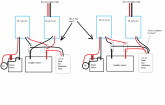Solarfun4jim
Solar seduced :-)
Hi folks, i'm looking specifically to UK van/motorhome dwellers to provide a schematic or rough diagram of their layout, with specific reference to meeting UK code on grounding/earthing, chassis ground etc.
Some appear to have no 'units' bonded to chassis, only the negative busbar. It all seems to get more confusing when 'occasionally/non permanently' connected to grid power through to the inverter/charger units. This also seems to vary considerably from country to country. Any experienced UK based folks that can give a difinitive answer as to the safest way to connect everything up. Assume that 99% of time there will be no grid connection in my example.
Is all bonding done via the negative busbar? Other than the 'straight through' power of the grid connect to the inverter /charger (which carries its earth connection from the grid power source, what other earthing cables are necessary? Bond solar panel frames to chassis? Everything else through negative connection to busbar?
When no grid connection, does this still provide reliable safety for the inverted 240vac to the consumer panel, with no true earth connection.
Hear so much conflicting info, cant get my head into a positive place....and with electricity, i need to be there.
Any help offered would be most graciously recieved. A layman trying to read up on the IEE Wiring Regulations (17th edition) 2008 etc, simply gets bogged down. :-(
Some appear to have no 'units' bonded to chassis, only the negative busbar. It all seems to get more confusing when 'occasionally/non permanently' connected to grid power through to the inverter/charger units. This also seems to vary considerably from country to country. Any experienced UK based folks that can give a difinitive answer as to the safest way to connect everything up. Assume that 99% of time there will be no grid connection in my example.
Is all bonding done via the negative busbar? Other than the 'straight through' power of the grid connect to the inverter /charger (which carries its earth connection from the grid power source, what other earthing cables are necessary? Bond solar panel frames to chassis? Everything else through negative connection to busbar?
When no grid connection, does this still provide reliable safety for the inverted 240vac to the consumer panel, with no true earth connection.
Hear so much conflicting info, cant get my head into a positive place....and with electricity, i need to be there.
Any help offered would be most graciously recieved. A layman trying to read up on the IEE Wiring Regulations (17th edition) 2008 etc, simply gets bogged down. :-(
Last edited:




